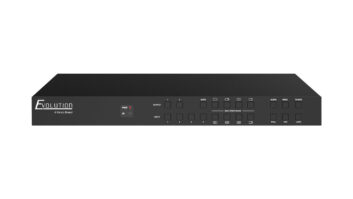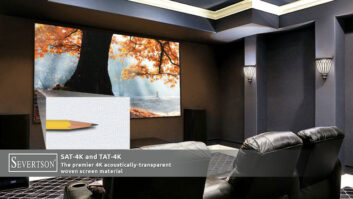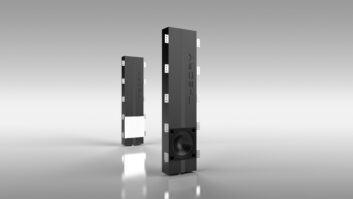NEW YORK – Major component-audio suppliers are ready for UltraHD 4K video, but some are more ready than others.
Last year, all of the largest audio-electronics suppliers offered component A/V receivers (AVRs), including opening-price models, with HDMI inputs and outputs that support 30 fps 4K UltraHD passthrough and up-scaling. This year, major suppliers of AVRs and surround processors adopted the next major step in UltraHD compatibility: HDMI 2.0 inputs and outputs that, at a minimum, support the passthrough of 4K content at 60 fps to deliver smoother action sequences.
Some AVRs and preamp processors also support step-up HDMI 2.0 features, including 4:4:4 color for 60 fps 4K video and the 21:9 widescreen theater aspect ratio.
All 2014 Pioneer AVRs deliver the 2.0 spec’s maximum 18Gbps data rate, enabling passthrough of RGB 4:4:4 color with 60 fps 4K UHD video. Other HDMI 2.0 AVRs support the passthrough of 4:4:4 for 4K 24/25/30 fps video but not for 4K 60 fps video.
Pioneer’s AVRs start at $249.
With 18Gbps HDMI ports, the Pioneer AVRs also support, if available in future sources, high-dynamic range capability, 32 audio channels and other enhancements enabled by higher speeds.
For its part, Onkyo offers HDMI 2.0 in all 2014 AVRs, starting with the opening price TX-SR333 at a suggested $299. Onkyo AVRs support 10.2Gbps HDMI 2.0, enabling 4:2:0 color at 4K/60 and the 21:9 aspect ratio.
For its part, Integra includes 10.2Gbps HDMI 2.0 in all of its 2014 audio components.
Yamaha, Denon, Sony and Marantz also offer HDMI 2.0 in 2014 audio components.
HDCP 2.2: The next step in audio’s 4K evolution is the incorporation of HDMI 2.0 ports with HDCP 2.2 copy-protection technology. Onkyo already offers AVRs with HDCP 2.2, and Integra offers AVRs and a preamp/processor with HDCP 2.2. Sony announced plans for its first three AVRs with the copy-protection technology, and Krell announced an upgrade package for its Foundation preamp/surround processor to add HDMI 2.0 inputs for the first time, all with HDCP 2.2 copy protection.
Likewise, Leaf Audio unveiled what it called the industry’s first HDMI matrix switches with HDCP 2.2 to distribute protected UHD video around the house.
HDCP 2.2 is needed in audio components to pass through copy-protected 4K studio content from future 4K set-top streaming boxes, future 4K disc players, and future 4K cable and satellite boxes to HDCP 2.2-equipped TVs for display. Without HDCP 2.2, the displays will go black, said one supplier.
AVRs and preamp processors lacking HDCP 2.2, however, will still be viable components in a 4K home theater, suppliers said. That’s because future 4K disc players and some set-top streaming boxes will likely come with dual HDMI outputs, just as some Blu-ray players do today. Consumers would connect one HDMI 2.0/HDCP 2.2 output from the player or set-top box directly to an HDCP 2.2-equipped TV. The second HDMI output would go to the AVR to deliver Dolby TrueHD, Dolby Atmos and DTS HD Master surround-sound soundtracks for decoding.
Sony’s latest 4K media server, the $699 FMP-X10, already takes that approach with its dual HDMI 2.0 outputs. The server features one HDCP 2.2-equipped HDMI 2.0 output that feeds audio and video direct to an HDCP 2.2-equipped AVR, which then passes the video signal through to an HDCP 2.2-equipped TV. If the AVR lacks HDCP 2.2, consumers would connect the server’s HDCP 2.2 output to the TV and then connect the server’s second HDMI output to the AVR.
The Sony server downloads hundreds of titles from Sony’s Video Unlimited 4K service for storage on its 1TB hard drive and will stream 4K content from Netflix.
Cost considerations: Many component-audio suppliers left out HDCP 2.2 from their AVRs and preamp processors this year because of cost and a lack of HDCP 2.2 TVs with which to test HDCP 2.2 AVRs for compatibility.
Chris Walker, Pioneer’s product planning director for home electronics, pointed out that a single-chip solution combining 18Gbps HDMI 2.0 and HDCP 2.2 isn’t yet available, and a two-chip solution would be more expensive and would prevent Pioneer from keeping 2014 AVR pricing flat.
“Nothing [in one-chip solutions] was available that supported HDMI 2.0 with full 18Gbps bandwidth that also supported HDCP 2.2,” he explained. “A two-chip expensive solution would have been required. Also, the lack of HDCP 2.2 televisions for compatibility testing was an issue.”
Current HDMI 2.0 receivers can’t be upgraded via firmware to add HDCP 2.2, he and other suppliers said.
To date, select active soundbars feature HDMI 2.0 but none features HDCP 2.2.













